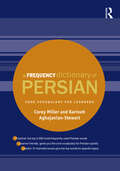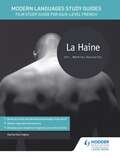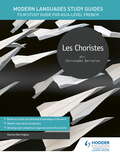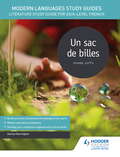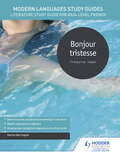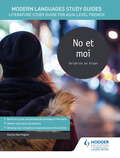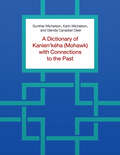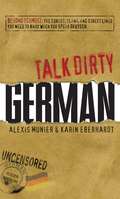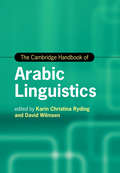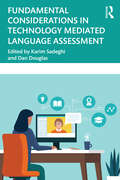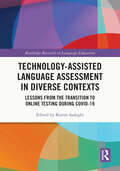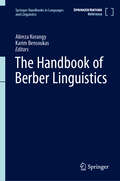- Table View
- List View
Easy Ways to Enlarge Your German Vocabulary
by Karl A. SchmidtAlthough there are many books that cover German grammar and syntax, remarkably little modern attention has been given to the practical problem of acquiring a German vocabulary. Yet building up or enlarging a basic vocabulary can be one of the most time-consuming and most difficult tasks for the student, if he approaches it by the conventional method of word lists or reading notes. As the present book, by Karl A. Schmidt, Assistant Professor of German at the University of San Francisco, shows, there are modern techniques for building vocabulary efficiently.Professor Schmidt's work builds upon the close relationship of German to English, as well as upon the easy and rational processes that are used in German for word formation. Cognates and words of common foreign origin between English and German are covered, as well as the creation of new words by compounding, by affixes, and other modifications. Concentrating on useful, modern vocabulary, this book is remarkably clear in its presentation and will (in addition to its specific considerations) leave the reader with a sense of the patterns of word formation, so that he can go farther on his own.This book can be used as a supplement to any language course, for self-study by a student who has already had grammatical basics, or as a refresher. The extensive practice examples that are included (with a key at the rear) will enable the reader both to increase his knowledge and to check his progress.
A Frequency Dictionary of Persian: Core vocabulary for learners (Routledge Frequency Dictionaries)
by Corey Miller Karineh Aghajanian-StewartA Frequency Dictionary of Persian is an invaluable tool for all learners of Persian, providing a list of the 5,000 most frequently used words in the language. Based on a 150 million word corpus of written and spoken Persian texts from the Iranian world, the Dictionary provides the user with a detailed frequency-based list, plus alphabetical and part-of-speech indices. All entries feature the English equivalent, and an example of use in context. The Dictionary also features thematically-based lists of frequently used words on a variety of topics. Also featured are some grammatically-oriented lists, such as simple verbs and light verb constructions, and comparisons of different ways of expressing the months of the year. The Dictionary provides a rich resource for language teaching and curriculum design, while a separate CD version provides the full text in a tab-delimited format ideally suited for use by corpus and computational linguists. A Frequency Dictionary of Persian enables students of all levels to build on their study of Persian in an efficient and engaging way.
Modern Languages Study Guides: Film Study Guide for AS/A-level French
by Karine HarringtonFilm analysis made easy. Build your students' confidence in their language abilities and help them develop the skills needed to critique their chosen work: putting it into context, understanding the themes and director's technique, as well as specialist terminology.Breaking down each scene, character and theme in Au revoir les enfants, this accessible guide will enable your students to understand the historical and social context of the film and give them the critical and language skills needed to write a successful essay.- Strengthen language skills with relevant grammar, vocab and writing exercises throughout- Aim for top marks by building a bank of textual examples and quotes to enhance exam response- Build confidence with knowledge-check questions at the end of every chapter- Revise effectively with pages of essential vocabulary and key mind maps throughout- Feel prepared for exams with advice on how to write an essay, plus sample essay questions, two levels of model answers and examiner commentary
Modern Languages Study Guides: Film Study Guide for AS/A-level French
by Karine HarringtonFilm and Literature analysis made easy. Build your students' confidence in their language abilities and help them develop the skills needed to critique their chosen work; putting it into context, understanding the themes and director's technique, as well as specialist terminology.Breaking down each scene, character and theme in La Haine, this accessible guide will enable your students to understand the historical and social context of the film and give them the critical and language skills needed write a successful essay.- Strengthen language skills with relevant grammar, vocab and writing exercises throughout- Aim for top marks by building a bank of textual examples and quotes to enhance exam response- Build confidence with knowledge check questions at the end of every chapter- Revise effectively with pages of essential vocabulary and key mind maps throughout- Feel prepared for exams with advice on how to write an essay, plus sample essay questions, two levels of model answers and examiner commentary
Modern Languages Study Guides: Film Study Guide for AS/A-level French
by Karine HarringtonFilm analysis made easy. Build your students' confidence in their language abilities and help them develop the skills needed to critique their chosen work: putting it into context, understanding the themes and director's technique, as well as specialist terminology.Breaking down each scene, character and theme in Les Choristes (The Choir), this accessible guide will enable your students to understand the historical and social context of the film and give them the critical and language skills needed to write a successful essay.- Strengthen language skills with relevant grammar, vocab and writing exercises throughout- Aim for top marks by building a bank of textual examples and quotes to enhance exam response- Build confidence with knowledge-check questions at the end of every chapter- Revise effectively with pages of essential vocabulary and key mind maps throughout- Feel prepared for exams with advice on how to write an essay, plus sample essay questions, two levels of model answers and examiner commentary
Modern Languages Study Guides: Film Study Guide for AS/A-level French
by Karine HarringtonFilm analysis made easy. Build your students' confidence in their language abilities and help them develop the skills needed to critique their chosen work: putting it into context, understanding the themes and director's technique, as well as specialist terminology.Breaking down each scene, character and theme in Les Choristes (The Choir), this accessible guide will enable your students to understand the historical and social context of the film and give them the critical and language skills needed to write a successful essay.- Strengthen language skills with relevant grammar, vocab and writing exercises throughout- Aim for top marks by building a bank of textual examples and quotes to enhance exam response- Build confidence with knowledge-check questions at the end of every chapter- Revise effectively with pages of essential vocabulary and key mind maps throughout- Feel prepared for exams with advice on how to write an essay, plus sample essay questions, two levels of model answers and examiner commentary
Modern Languages Study Guides: Film Study Guide for AS/A-level French (Film and literature guides)
by Karine HarringtonExam Board: AQA, Edexcel & EduqasLevel: AS/A-levelSubject: Modern LanguagesFirst Teaching: September 2016First Exam: June 2017Film analysis made easy. Build your students' confidence in their language abilities and help them develop the skills needed to critique their chosen work: putting it into context, understanding the themes and director's technique, as well as specialist terminology.Breaking down each scene, character and theme in Au revoir les enfants (Goodbye, Children), this accessible guide will enable your students to understand the historical and social context of the film and give them the critical and language skills needed to write a successful essay.- Strengthen language skills with relevant grammar, vocab and writing exercises throughout- Aim for top marks by building a bank of textual examples and quotes to enhance exam response- Build confidence with knowledge-check questions at the end of every chapter- Revise effectively with pages of essential vocabulary and key mind maps throughout- Feel prepared for exams with advice on how to write an essay, plus sample essay questions, two levels of model answers and examiner commentary
Modern Languages Study Guides: Film Study Guide for AS/A-level French (Film and literature guides)
by Karine HarringtonExam Board: AQA, Edexcel & EduqasLevel: AS/A-levelSubject: Modern LanguagesFirst Teaching: September 2016First Exam: June 2017Film analysis made easy. Build your students' confidence in their language abilities and help them develop the skills needed to critique their chosen work: putting it into context, understanding the themes and director's technique, as well as specialist terminology.Breaking down each scene, character and theme in La Haine (Hate), this accessible guide will enable your students to understand the historical and social context of the film and give them the critical and language skills needed to write a successful essay.- Strengthen language skills with relevant grammar, vocab and writing exercises throughout- Aim for top marks by building a bank of textual examples and quotes to enhance exam response- Build confidence with knowledge-check questions at the end of every chapter- Revise effectively with pages of essential vocabulary and key mind maps throughout- Feel prepared for exams with advice on how to write an essay, plus sample essay questions, two levels of model answers and examiner commentary
Modern Languages Study Guides: Literature Study Guide for AS/A-level French
by Karine HarringtonExam Board: AQA, Edexcel, OCR & WJECLevel: AS/A-levelSubject: Modern LanguagesFirst Teaching: September 2016First Exam: June 2017Literature analysis made easy. Build your students' confidence in their language abilities and help them develop the skills needed to critique their chosen work: putting it into context, understanding the themes and narrative technique, as well as specialist terminology.Breaking down each scene, character and theme in Un Sac de Billes (A Bag of Marbles), this accessible guide will enable your students to understand the historical and social context of the novel and give them the critical and language skills needed to write a successful essay.- Strengthen language skills with relevant grammar, vocab and writing exercises throughout- Aim for top marks by building a bank of textual examples and quotes to enhance exam response- Build confidence with knowledge-check questions at the end of every chapter- Revise effectively with pages of essential vocabulary and key mind maps throughout- Feel prepared for exams with advice on how to write an essay, plus sample essay questions, two levels of model answers and examiner commentary
Modern Languages Study Guides: Literature Study Guide for AS/A-level French
by Karine HarringtonLiterature analysis made easy. Build your students' confidence in their language abilities and help them develop the skills needed to critique their chosen work: putting it into context, understanding the themes and narrative technique, as well as specialist terminology.Breaking down each scene, character and theme in Bonjour tristesse (Hello sadness) this accessible guide will enable your students to understand the historical and social context of the novel and give them the critical and language skills needed to write a successful essay.- Strengthen language skills with relevant grammar, vocab and writing exercises throughout- Aim for top marks by building a bank of textual examples and quotes to enhance exam response- Build confidence with knowledge-check questions at the end of every chapter- Revise effectively with pages of essential vocabulary and key mind maps throughout- Feel prepared for exams with advice on how to write an essay, plus sample essay questions, two levels of model answers and examiner commentary
Modern Languages Study Guides: Literature Study Guide for AS/A-level French
by Karine HarringtonExam Board: AQA, Edexcel, OCR & WJECLevel: AS/A-levelSubject: Modern LanguagesFirst Teaching: September 2016First Exam: June 2017Literature analysis made easy. Build your students' confidence in their language abilities and help them develop the skills needed to critique their chosen work: putting it into context, understanding the themes and narrative technique, as well as specialist terminology.Breaking down each scene, character and theme in No et moi (No and Me), this accessible guide will enable your students to understand the historical and social context of the novel and give them the critical and language skills needed to write a successful essay.- Strengthen language skills with relevant grammar, vocab and writing exercises throughout- Aim for top marks by building a bank of textual examples and quotes to enhance exam response- Build confidence with knowledge-check questions at the end of every chapter- Revise effectively with pages of essential vocabulary and key mind maps throughout- Feel prepared for exams with advice on how to write an essay, plus sample essay questions, two levels of model answers and examiner commentary
Modern Languages Study Guides: Literature Study Guide for AS/A-level French
by Karine HarringtonLiterature analysis made easy. Build your students' confidence in their language abilities and help them develop the skills needed to critique their chosen work: putting it into context, understanding the themes and narrative technique, as well as specialist terminology.Breaking down each scene, character and theme in Bonjour tristesse (Hello sadness) this accessible guide will enable your students to understand the historical and social context of the novel and give them the critical and language skills needed to write a successful essay.- Strengthen language skills with relevant grammar, vocab and writing exercises throughout- Aim for top marks by building a bank of textual examples and quotes to enhance exam response- Build confidence with knowledge-check questions at the end of every chapter- Revise effectively with pages of essential vocabulary and key mind maps throughout- Feel prepared for exams with advice on how to write an essay, plus sample essay questions, two levels of model answers and examiner commentary
Modern Languages Study Guides: Literature Study Guide for AS/A-level French (Film and literature guides)
by Karine HarringtonExam Board: AQA, Edexcel, Eduqas & CCEALevel: AS/A-levelSubject: Modern LanguagesFirst Teaching: September 2016First Exam: June 2017Literature analysis made easy. Build your students' confidence in their language abilities and help them develop the skills needed to critique their chosen work: putting it into context, understanding the themes and narrative technique, as well as specialist terminology.Breaking down each scene, character and theme in No et moi (No and Me), this accessible guide will enable your students to understand the historical and social context of the novel and give them the critical and language skills needed to write a successful essay.- Strengthen language skills with relevant grammar, vocab and writing exercises throughout- Aim for top marks by building a bank of textual examples and quotes to enhance exam response- Build confidence with knowledge-check questions at the end of every chapter- Revise effectively with pages of essential vocabulary and key mind maps throughout- Feel prepared for exams with advice on how to write an essay, plus sample essay questions, two levels of model answers and examiner commentary
Modern Languages Study Guides: Literature Study Guide for AS/A-level French (Film and literature guides)
by Karine HarringtonExam Board: AQA & EdexcelLevel: AS/A-levelSubject: Modern LanguagesFirst Teaching: September 2016First Exam: June 2017Literature analysis made easy. Build your students' confidence in their language abilities and help them develop the skills needed to critique their chosen work: putting it into context, understanding the themes and narrative technique, as well as specialist terminology.Breaking down each scene, character and theme in Un Sac de Billes (A Bag of Marbles), this accessible guide will enable your students to understand the historical and social context of the novel and give them the critical and language skills needed to write a successful essay.- Strengthen language skills with relevant grammar, vocab and writing exercises throughout- Aim for top marks by building a bank of textual examples and quotes to enhance exam response- Build confidence with knowledge-check questions at the end of every chapter- Revise effectively with pages of essential vocabulary and key mind maps throughout- Feel prepared for exams with advice on how to write an essay, plus sample essay questions, two levels of model answers and examiner commentary
Jagannath
by Karin TidbeckAn award-winning debut story collection by Karin Tidbeck, author of Amatka and heir to Borges, Le Guin, and Lovecraft.A child is born in a tin can. A switchboard operator finds himself in hell. Three corpulent women float somewhere beyond time. Welcome to the weird world of Karin Tidbeck, the visionary Swedish author of literary sci-fi, speculative fiction, and mind-bending fantasy who has captivated readers around the world. Originally published by the tiny press Cheeky Frawg--the passion project of Ann and Jeff VanderMeer--Jagannath has been celebrated by readers and critics alike, with rave reviews from major outlets and support from lauded peers like China Miéville and even Ursula K. Le Guin herself. These are stories in which fairies haunt quiet towns, and an immortal being discovers the nature of time--stories in which anything is possible.
A Dictionary of Kanien’kéha (Mohawk) with Connections to the Past
by Karin Michelson Gunther Michelson Glenda Canadian DeerThis dictionary provides a record of the Kanien’kéha (Mohawk) language as spoken by fluent first- and second-language speakers at the Kanien’kéha Mohawk Territory outside of Montréal, Canada. The Kanien’kéha language has been written since the 1600s, and these dictionary entries include citations from published, archival, and informal writings from the seventeenth century onwards. These citations are a legacy of the substantial documents of missionary scholars and several informal vocabulary lists written by Kanien’kéha speakers, among others. The introduction to the dictionary provides a description of the organization and orthography of the historical works so that they can be used in the future by those studying and learning the language. A Dictionary of Kanien’kéha (Mohawk) with Connections to the Past allows scholars and students to learn the meaning, composition, and etymology of words in a language known for its particularly complex word structure. The organization of the entries, according to noun and verb roots, highlights the remarkable potential and adaptability of the language to express traditional concepts, as well as innovations that have resulted from contact with other customs and languages that have become part of the contemporary culture of the Kanien’kehá:ka.
Talk Dirty German
by Alexis Munier Karin EberhardtSprechen SieDirtyDeutsch? If you think German is allbratand nowurst, you need to think again. German is sexier'and dirtier'than you might imagine. (Think Hamburg!) From hearts and violins to pigs and dogs, Goethe's native tongue is ripe'and rank'with creative obscenities, including: Kuck mal diese geile Schnitte! Look at that sexy chick! Literal translation: Look at that sexy slice! Alle wissen dass Klaus sehr gut geigt . Everyone knows Klaus f**ks well. Literal translation: Everyone knows Klaus plays the violin well. Markus, du bist ein verdammter Schweinehund. Markus, you're a f**king moron. Literal translation: Markus, you are a damned pig dog. In this book, you receive a basic introduction into the netherworlds (and nether regions) of the trueJargon. Whether seducing aM'dchenin M'nchen or aKerlin K'ln, this gritty linguistic guide is all you need to know to talk dirty the German way.
Talk Dirty German
by Alexis Munier Karin EberhardtSprechen Sie Dirty Deutsch?If you think German is all brat and no wurst, you need to think again. German is sexier--and dirtier--than you might imagine. (Think Hamburg!) From hearts and violins to pigs and dogs, Goethe's native tongue is ripe--and rank--with creative obscenities, including: Kuck mal diese geile Schnitte!Look at that sexy chick!Literal translation: Look at that sexy slice!Alle wissen dass Klaus sehr gut geigt.Everyone knows Klaus f**ks well.Literal translation: Everyone knows Klaus plays the violin well.Markus, du bist ein verdammter Schweinehund.Markus, you're a f**king moron.Literal translation: Markus, you are a damned pig dog.In this book, you receive a basic introduction into the netherworlds (and nether regions) of the true Jargon. Whether seducing a Mädchen in München or a Kerl in Köln, this gritty linguistic guide is all you need to know to talk dirty the German way.
The Cambridge Handbook of Arabic Linguistics (Cambridge Handbooks in Language and Linguistics)
by Karin Christina Ryding David WilmsenArabic linguistics encompasses a range of language forms and functions from formal to informal, classical to contemporary, written to spoken, all of which have vastly different research traditions. Recently however, the increasing prominence of new methodologies such as corpus linguistics and sociolinguistics have allowed Arabic linguistics to be studied from multiple perspectives, revealing key discoveries about the nature of Arabic-in-use and deeper knowledge of traditional fields of study. With contributions from internationally renowned experts on the language, this handbook provides a state-of-the-art overview of both traditional and modern topics in Arabic linguistics. Chapters are divided into six thematic areas: applied Arabic linguistics, variation and sociolinguistics, theoretical studies, computational and corpus linguistics, new media studies and Arabic linguistics in literature and translation. It is an essential resource for students and researchers wishing to explore the exciting and rapidly moving field of Arabic linguistics.
A Reference Grammar of Modern Standard Arabic
by Karin C. RydingKeeping technical terminology to a minimum, this comprehensive handbook provides a detailed yet accessible overview of Arabic wherein its phonology, morphology and syntax can be readily accessed. Accompanied by extensive examples, it will prove an invaluable practical guide for supporting students' textbooks, classroom work or self-study, and a useful resource for scholars and professionals.
Arabic
by Karin C. RydingThis new edition, updated and with additional exercises, equips those who work, travel, and study in Arab countries with an educated form of spoken Arabic that functions flexibly in the face of various regional colloquial variants in the Arab world. Because the Arabic language has a number of very different spoken vernaculars, being able to speak and be understood in all Arab countries has become a challenge for English speakers. Ryding and Mehall have designed a course that teaches a standardized variant of spoken Arabic that is close to, but more natural than, the literary Modern Standard Arabic. With a non-grammar-based approach, this book fosters communicative competence in Arabic on all levels and develops speaking proficiency without abandoning Arabic script. It has proven to be clear, effective, and relevant to the needs of Americans living and working in the Arab East. Task-based lessons feature basic dialogues between Americans and Arabs, explanations of new structures, vocabulary expansion, and exercises; and provide gradual access to the sounds and script of Arabic by emphasizing listening and reading comprehension first, then slowly adding oral exercises and activities until the student has achieved basic proficiency. Not intended for self-instruction for beginners, Formal Spoken Arabic Basic Course with MP3 Files assumes some previous knowledge of Modern Standard Arabic, Arabic script and phonology, and previous or simultaneous instruction in orthography. This new edition includes a CD of MP3 audio exercises that are keyed to the text and drill students on listening and speaking. Lessons cover topics including:Heads of StateCities and CountriesOfficial TitlesGeographySystems of GovernmentLost LuggageGetting AcquaintedEstablishing Common GroundSeeking and Giving InformationPersonal Needs and FamilyHandling ProblemsEating OutBargaining and Buying
Fundamental Considerations in Technology Mediated Language Assessment
by Karim Sadeghi and Dan DouglasFundamental Considerations in Technology Mediated Language Assessment aims to address issues such as how the forced integration of technology into second language assessment has shaped our understanding of key traditional concepts like validity, reliability, washback, authenticity, ethics, fairness, test security, and more. Although computer assisted language testing has been around for more than two decades in the context of high-stakes proficiency testing, much of language testing worldwide has shifted to 'at home' mode, and relies heavily on the mediation of digital technology, making its widespread application in classroom settings in response to the COVID-19 outbreak as unprecedented. Integration of technology into language assessment has brought with it countless affordances and at the same time challenges, both theoretically and practically. One major theoretical consideration requiring attention is the way technology has contributed to a re-conceptualisation of major assessment concepts/constructs. There is very limited literature available on theoretical underpinnings of technology mediated language assessment. This book aims to fill this gap. This book will appeal to academic specialists, practitioners or professionals in the field of language assessment, advanced and/or graduate students, and a range of scholars or professionals in disciplines like educational technology, applied linguistics and TESOL.
Technology-Assisted Language Assessment in Diverse Contexts: Lessons from the Transition to Online Testing during COVID-19 (Routledge Research in Language Education)
by Karim SadeghiThis timely collection explores the role of digital technology in language education and assessment during the COVID-19 pandemic. It recognises the unique pressures which the COVID-19 pandemic placed on assessment in language education, and examines the forced shift in assessment strategies to go online, the existing shortfalls, as well as unique affordances of technology-assisted L2 assessment. By showcasing international examples of successful digital and computer-assisted proficiency and skills testing, the volume addresses theoretical and practical concerns relating to test validity, reliability, ethics, and student experience in a range of testing contexts. Particular attention is given to identifying lessons and implications for future research and practice, and the challenges of implementing unplanned computer-assisted language assessment during a crisis. Insightfully unpacking the ‘lessons learned’ from COVID and its impact on the acceleration of the shift towards online course and assessment delivery, it offers important guidelines for navigating assessment in different instructional settings in times of crisis. It will appeal to scholars, researchers, educators, and faculty with interests in educational measurement, digital education and technology, and language assessment and testing.
The Handbook of Berber Linguistics (Springer Handbooks in Languages and Linguistics)
by Alireza Korangy Karim BensoukasThis handbook is the largest and most comprehensive publication on Berber linguistics to date, covering the variety of Berber dialects and related linguistics trends. Extensive and diverse at thematic and theoretical levels, with the aim of deepening students and scholars' understanding of the workings of Berber as a linguistic phenomenon, it explores a multitude of angles through which the diachronic and synchronic intricacies of Berber varieties can be examined. It enables a better understanding of the issues in the various components of North African languages, as well as their theoretical and typological significance and implications. The work covers phonology and phonetics, morphology and syntax, semantics and pragmatics, socio-linguistics and dialectology, language teaching and psycholinguistics, lexicology, language contact and comparative linguistics, historical linguistics and etymology. Sub-themes explored include prosody, ideophones (and expressive language in general), morpho-syntactic categories, sociolinguistic variation and several other seminal interdisciplinary explorations. The chapters reflect the diversity of Berber varieties and include up-to-date scholarship by leading Berberists, with varieties including Figuig, Kabyle, Senhaja, Siwa, Standard Moroccan Amazigh, Tamazight, Tarifit, Tashlhit, Touareg, Tunisian Berber, Znaga, as well as Proto-Berber. A large geographical territory is covered, including Algeria, Egypt, Libya, Mali, Mauritania, Morocco, and Tunisia. With contributions from these Berber-speaking countries and their diaspora, there are also chapters from prominent Berber scholars from America, Australia and Europe. To this end, the volume includes perspectives and theories from different schools of linguistics. In including original French contributions and English translations of research from top scholars in the field, the book includes another vital dimension in terms ofthe resources, and sources. As a comprehensive reference, this work is of interest to North Africanists from various disciplines, including anthropologists, linguists, and sociologists, but particularly linguists interested in endangered languages, and those working on the historical and comparative study of the Afroasiatic language phylum.

